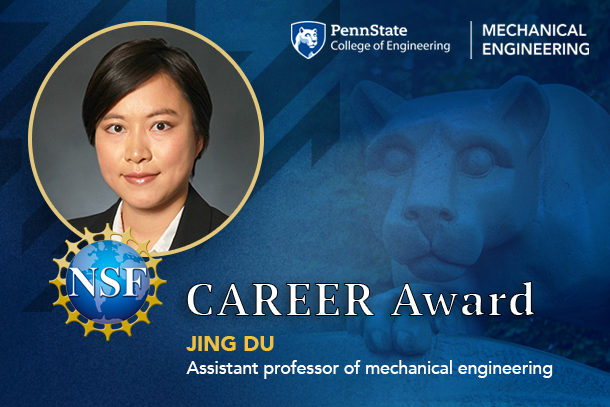
Jing Du, assistant professor of mechanical engineering at Penn State, earned a five-year, $552,606 NSF CAREER Award. Credit: Penn State.
2022 NSF CAREER Award: Jing Du
2/28/2022
UNIVERSITY PARK, Pa. — Jing Du, assistant professor of mechanical engineering at Penn State, earned a five-year, $552,606 NSF CAREER Award for a project titled “Structures and Properties of Bone at Multiple Length Scales.”
What do you want to understand or solve through this project?
Bone is a typical mineralized biological tissue that exhibits superior mechanical properties. It is strong and tough, yet lightweight, which can be attributed to its hierarchical structures — also known as structures at multiple length scales. However, the structures in the bone at the sub-micron and nanoscales are still not well understood. The research objective of this project is to determine the composition-structure-property relationships in bone at multiple length scales, using integrated experiments and models.
The central hypothesis is that the bulk properties of bone (strength, toughness, adaptation) are related to the composition, structure and properties in its microscale structures (cement line and sub-lamellae) and nanoscale ultrastructure (mineralized collagen fibril and extrafibrillar matrix). We will first develop correlative microscopy techniques to characterize composition, structure, and properties for ultrastructure and microstructure of bone. Then in cortical bone and trabecular bone, the composition-structure-property across multiple length scales will be determined, respectively. Finally, the peri-implant bone adaptation will be investigated in terms of its extrinsic morphology and intrinsic properties.
How will advances in this area impact society?
A deeper understanding of bone can provide insights to fracture prediction and benefit the aging population and people with bone disorders. There are 10.2 million American people aged 50 and over with osteoporosis, which may lead to an increased risk of fracture.
The new knowledge about bone will also provide inspiration for the design of more robust manmade materials; enable the advancement in biomedical materials; be extended to the research of other natural biocomposites; and significantly impact the broad range of applications in transportation, buildings, defense, biomedicine and energy.
Will undergraduate or graduate students contribute to this research? How?
The education and outreach activities in this project will build a pipeline to include more students in STEM fields. Undergraduate and graduate students will be educated and trained on interdisciplinary (materials and medicine) bone research. Students interested in participating should email me at jingdu@psu.edu for more information.
The NSF CAREER Award not only funds a research project, but it also recognizes the potential of the recipient as a researcher, educator and leader in their field. How do you hope to fulfill that potential?
Our long-term goal is to contribute to human well-being by advancing the science of biological materials and bioinspired materials through the synergistic integration of research, education and outreach. This NSF CAREER project focuses on a few model systems of these materials: cortical bone, trabecular bone and peri-implant bone. Also, we aim to provide an inclusive biomaterials research and education environment that is equally welcoming for students and scholars with different backgrounds.
This project builds on the prior works done by my former and current graduate students and undergraduate students, including Yuxiao Zhou, Kangning Su, Yichun Tang, Chujie Gong, and Michael Hernandez. I'd like to extend my gratitude to my collaborators, Assistant Professor Shengxi Huang, Professor April Armstrong, Associate Professor Gregory Lewis, and Professor Mehran Hossaini at Temple University. Also, I'd like to thank Tim Tighe at the Penn State Materials Characterization Lab and Tim Stecko at the Penn State Center for Quantitative Imaging for providing technical support.



